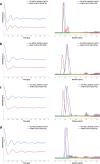Spectroscopically Orthogonal Labelling to Disentangle Site-Specific Nitroxide Label Distributions
- PMID: 38357007
- PMCID: PMC10861635
- DOI: 10.1007/s00723-023-01611-1
Spectroscopically Orthogonal Labelling to Disentangle Site-Specific Nitroxide Label Distributions
Abstract
Biomolecular applications of pulse dipolar electron paramagnetic resonance spectroscopy (PDS) are becoming increasingly valuable in structural biology. Site-directed spin labelling of proteins is routinely performed using nitroxides, with paramagnetic metal ions and other organic radicals gaining popularity as alternative spin centres. Spectroscopically orthogonal spin labelling using different types of labels potentially increases the information content available from a single sample. When analysing experimental distance distributions between two nitroxide spin labels, the site-specific rotamer information has been projected into the distance and is not readily available, and the contributions of individual labelling sites to the width of the distance distribution are not obvious from the PDS data. Here, we exploit the exquisite precision of labelling double-histidine (dHis) motifs with CuII chelate complexes. The contribution of this label to the distance distribution widths in model protein GB1 has been shown to be negligible. By combining a dHis CuII labelling site with cysteine-specific nitroxide labelling, we gather insights on the label rotamers at two distinct sites, comparing their contributions to distance distributions based on different in silico modelling approaches and structural models. From this study, it seems advisable to consider discrepancies between different in silico modelling approaches when selecting labelling sites for PDS studies.
Supplementary information: The online version contains supplementary material available at 10.1007/s00723-023-01611-1.
© The Author(s) 2023.
Conflict of interest statement
Conflict of InterestAll authors declare that they have no conflict of interest.
Figures



Similar articles
-
A Comparison of Cysteine-Conjugated Nitroxide Spin Labels for Pulse Dipolar EPR Spectroscopy.Molecules. 2021 Dec 13;26(24):7534. doi: 10.3390/molecules26247534. Molecules. 2021. PMID: 34946616 Free PMC article.
-
Differentiating between Label and Protein Conformers in Pulsed Dipolar EPR Spectroscopy with the dHis-Cu2+ (NTA) Motif.Chemistry. 2023 Dec 22;29(72):e202302541. doi: 10.1002/chem.202302541. Epub 2023 Nov 6. Chemistry. 2023. PMID: 37755452
-
DEER and RIDME Measurements of the Nitroxide-Spin Labelled Copper-Bound Amine Oxidase Homodimer from Arthrobacter Globiformis.Appl Magn Reson. 2021;52(8):995-1015. doi: 10.1007/s00723-021-01321-6. Epub 2021 Mar 29. Appl Magn Reson. 2021. PMID: 34720439 Free PMC article.
-
Orthogonal spin labeling and pulsed dipolar spectroscopy for protein studies.Methods Enzymol. 2022;666:79-119. doi: 10.1016/bs.mie.2022.02.004. Epub 2022 Mar 17. Methods Enzymol. 2022. PMID: 35465930 Review.
-
Going the dHis-tance: Site-Directed Cu2+ Labeling of Proteins and Nucleic Acids.Acc Chem Res. 2021 Mar 16;54(6):1481-1491. doi: 10.1021/acs.accounts.0c00761. Epub 2021 Jan 21. Acc Chem Res. 2021. PMID: 33476119 Review.
Cited by
-
Expanding the Diversity of Nitroxide-Based Paramagnetic Probes Conjugated to Non-Canonical Amino Acids for Sdsl-Epr Applications.Chembiochem. 2025 Apr 1;26(7):e202500064. doi: 10.1002/cbic.202500064. Epub 2025 Mar 12. Chembiochem. 2025. PMID: 40011209 Free PMC article.
-
CRISPR antiphage defence mediated by the cyclic nucleotide-binding membrane protein Csx23.Nucleic Acids Res. 2024 Apr 12;52(6):2761-2775. doi: 10.1093/nar/gkae167. Nucleic Acids Res. 2024. PMID: 38471818 Free PMC article.
-
Pulse Dipolar Electron Paramagnetic Resonance Spectroscopy Distance Measurements at Low Nanomolar Concentrations: The CuII-Trityl Case.J Phys Chem Lett. 2024 Feb 8;15(5):1455-1461. doi: 10.1021/acs.jpclett.3c03311. Epub 2024 Jan 31. J Phys Chem Lett. 2024. PMID: 38294197 Free PMC article.
References
-
- Edwards DT, Huber T, Hussain S, Stone KM, Kinnebrew M, Kaminker I, Matalon E, Sherwin MS, Goldfarb D, Han S. Determining the oligomeric structure of proteorhodopsin by Gd3+-based pulsed dipolar spectroscopy of multiple distances. Structure. 2014;22:1677–1686. doi: 10.1016/j.str.2014.09.008. - DOI - PubMed
Grants and funding
LinkOut - more resources
Full Text Sources
Miscellaneous
